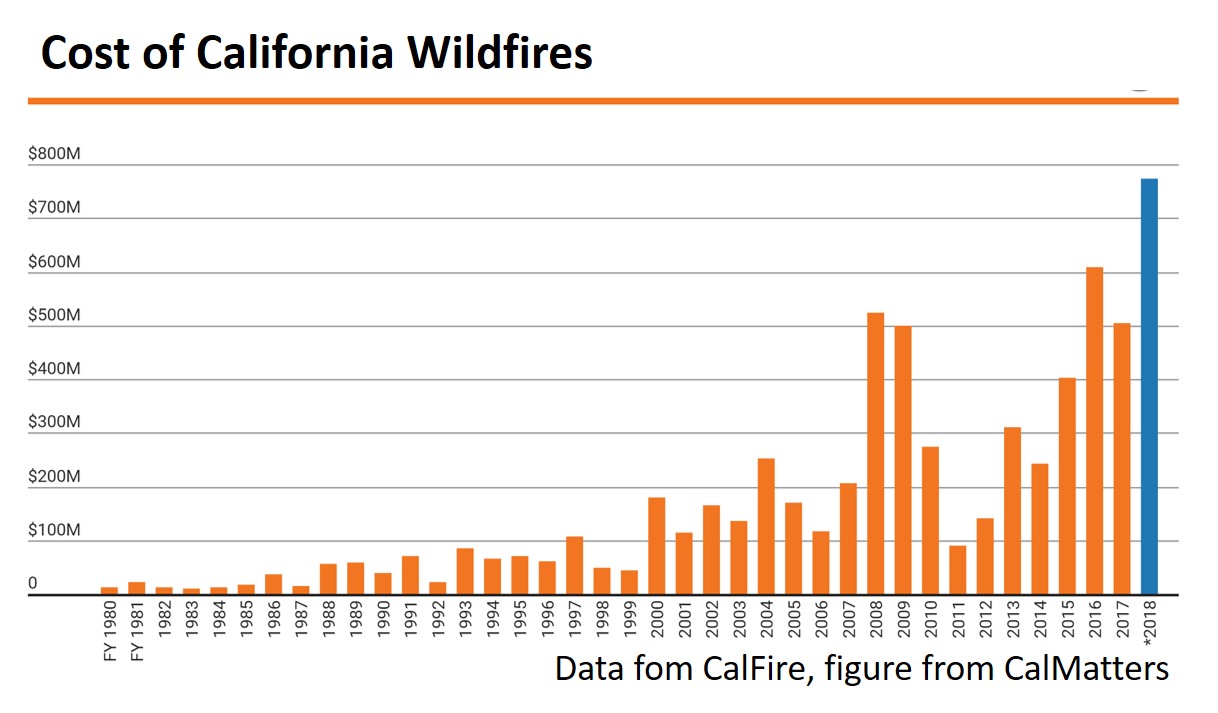The Issue
Recent years have shown that wildfires have increased in frequency and intensity. Climate change brings increased temperatures and droughts which exacerbate the risks. These trends coincide with decades of federal and state government suppression of naturally occurring fires that could have cleared out much of the thick flammable brush that makes fires spread so much more quickly today, coupled with human habitation moving into fire-prone areas. Together, climate change, poor forest management, and expanding population pressure are increasing wildfire risk.
Health and Well-Being: Many have lost lives, property, communities and businesses to fire. But even those not directly affected suffer from the smoke-filled air that spreads and lingers many miles from the fire sites.
Watersheds: Wildfires also threaten the health of California freshwater supplies. Burning building release toxic chemicals which reach our watersheds.
Exacerbates Climate Change: Combustion by wildfires releases carbon dioxide directly, and the loss of forest removes an important carbon sink, making the climate impact even worse.
Actions Needed
How can Americans reduce the number and intensity of wildfires and become more resilient when they occur? Issues surrounding wildfires that Americans are facing include:
- Wildfire insurance premium increases, or total withdrawals of rage, forcing mortgage holders to purchase costly state-administered plans
- Loss of offerings of wildfire insurance to property owners
- Dealing with planned blackouts, such as PG&E's
- Clearing of brush/forest thinning/controlled burning
- Improving grassland and forest health
- More restrictive zoning in suburban-rural boundary areas
- Encouraging microgrids and home-generated renewable energy (solar, wind) that mitigates dependency on large fire-threatened grid infratructure
LWVC Wildfire Team
Our LWVC Wildfire Team has League participants from counties in diverse parts of the state, including Santa Clara, Humboldt, Placer, San Mateo, and Alameda Counties.
In monthly meetings, we discuss policies and practices such as insurance, electrification, fire-detection and mitigation technologies, resilience-building through fire-resistant property improvements, forest management, and organizing property owners to join together in building resilience in their communities.
We invite non-League experts on fire issues to share their work and perspectives, monitor the status of related state legislation and state-federal coordination of forest management within California.
Some Key Issues in Current Discussion:
Human habitation in fire-prone areas: What role should the government play if any?
How to mitigate catastrophic wildfires:
• Better landscape management practices (e.g. forest pruning, prescribed burning, soil management, minimization of contaminant runoff and erosion).
• Research needed and how to support it.
Public education that mitigation is critical
• Property and life loss
• Climate change
• Public health
An overview was recently presented by the Wildfire Team: Climate Wildfire Challenges: An Overview
Resources
California Fire Hazard Severity Zone Viewer This interactive geospatial mapping tool by CAL FIRE shows in great detail levels of fire risk in different parts of CA, based on the most recent risk assessments.
U.S. Forest Service Vast reaches of California land are managed by the U.S. Forest Service. The search tool in this USFS web site yields links to national information resources about wildfires.
Forest Management This is a link to the U.S. Global Change Research Program website GlobalChange.gov, which conducts climate change assessments for the each U.S. region. The link opens a report describing how effective forest management can reduce wildfire risk.
Understanding California Wildfires An overview by California State University about the current challenges of wildfires in CA and what CSU faculty and students are doing about it.
Learning to Live with California Wildfires A video of an expert panel discussion about CA wildfires that occured in Nov 2019, sponsored by CalMatters.
Link to LA Times Pulitzer Prize winning Work on Wildfires Links to articles by Pulitzer Prize-winning Los Angeles Times journalists Bettina Boxall and Julie Cart about the cost and effectiveness of attempts to combat the growing menace of wildfires across the western United States.
How California Wildfires Are Changing Transcript of an interview with fire scientist Crystal Kolden of UC Merced about California’s “firescape” is changing, and what we can do about it, conducted by a representative of the Public Policy Institute of California.

